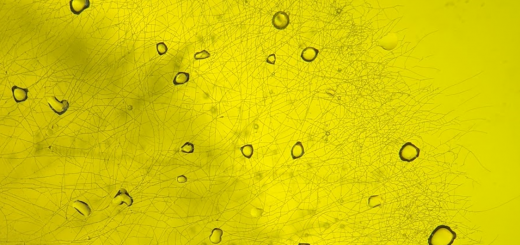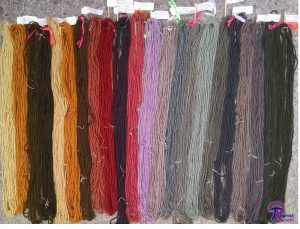#088: Types of Wood Rot
There are three main types of wood rot caused by fungi: brown rot, white rot, and soft rot. These rot types can be easily distinguished from one another by their color and texture. Of course, many fungi muddy the water by including characteristics from all three rot types. For now, though, I’ll just focus on the three main types.
Brown rot is easily recognized because it turns the affected wood brown. But wait, isn’t wood already brown? Well, yes. However, brown rotting fungi make the wood much darker. If you had a board that was half-decayed by a brown rotting fungus, you could easily pick out the darker, decayed half. Additionally, brown rotted wood becomes crumbly and cracks into roughly cubical sections. Brown rotting fungi are most often found in wood from conifer trees.
The color and texture of wood decayed by a brown rotter can be explained by the chemical processes employed by brown rotting fungi. These fungi degrade the cellulose in wood, but leave the lignin alone. Cellulose and lignin, of course, are the two main chemical components of wood. Different combinations of cellulose and lignin produce different types of wood with different structural properties. Lignin takes more energy to break down than does cellulose, so brown rotters conserve energy by ignoring the lignin. Brown rotted wood, therefore, gets its dark brown color and crumbly texture from the lignin left behind by the fungus.
White rot fungi, as you might guess, turn the wood white. Affected wood has a bleached appearance and a stringy texture. White rotting fungi can degrade the lignin in wood and have varied capacities to degrade cellulose. Some white rotters degrade both equally, leaving very little material behind. Others selectively degrade the brown lignin while completely ignoring the white, fibrous cellulose. White rot fungi usually attack the wood of hardwoods.
Lignin has a very complex structure, so white rotters have to be able to decompose polyaromatic hydrocarbons with a variety of chemical bonds. This ability has made these organisms very attractive to scientists working on bioremediation. White rotting fungi have been shown to degrade TNT, the infamous pesticide DDT, and other complex chemicals. However, these processes are slow and do not work particularly well in the field. This is hardly surprising, as it took fungi millions of years to figure out how to degrade lignin. In addition to bioremediation, white rotting fungi have potential applications in the field of biopulping. In the papermaking process, lignin is removed using bleaches and harsh chemicals. This improves the texture of the paper and decreases its toxicity (which makes the paper last longer). Some white rotting fungi have been investigated as potential alternatives to chemicals in papermaking.
The final type of fungal wood rot is called soft rot. Soft rotters can degrade both cellulose and lignin, but do so in a distinctive way. They grow through the wood by decomposing the wood around a hypha, branching, and then growing/decomposing further. The characteristic tubes that are produced combined with the degradation of both lignin and cellulose make the wood soft. Mnay soft rotters degrade more cellulose than lignin, making the wood slightly brown and broken up into cubes. However, the texture is not as crumbly as you would expect from a brown rotting fungus. Most soft rotters are members of the Ascomycota, but some Basidiomycota have evolved to carry out a very similar process under certain conditions.
As a final note, I would like to introduce the terms “heart rot” and “butt rot.” Heart rots are caused when fungi decompose the heartwood (the darker wood at the center of the tree) in a tree’s trunk and branches. Butt rots are caused when fungi decompose the wood at the base of the tree. These terms are often used when describing the fruiting habit of a wood decay mushroom, so they are good to know.
See Further:
http://botit.botany.wisc.edu/toms_fungi/may97.html
http://forestpathology.cfans.umn.edu/microbes.htm
http://www.hawaii.edu/abrp/Technologies/fungus.html
http://cool.conservation-us.org/byorg/abbey/ap/ap04/ap04-4/ap04-402.html
http://www.caes.uga.edu/extension/cobb/anr/Documents/WoodRot.pdf
http://science.energy.gov/ber/highlights/2012/ber-2012-06-a/








![#011: Characteristics of Kingdom Fungi [Archived]](https://www.fungusfactfriday.com/wp-content/themes/hueman/assets/front/img/thumb-small-empty.png)


4 Responses
[…] F. hepatica decomposes dead trees and is sometimes weakly parasitic on living trees. The mushroom most often grows on oaks and chestnuts, but sometimes attacks the wood of other hardwoods as well. It usually appears on recently dead trees, so look for it especially at the bases of dead but still standing trees. 1 F. hepatica may also produce mushrooms on stumps or logs of recently downed trees. 2 As I noted above, I have found it growing in mulch, although that was a rare occurrence. The fungus is a brown rot fungus, 1 so it primarily decomposes the wood’s cellulose (for more on types of rot, see FFF#088). […]
[…] In North America, Chlorociboria staining is usually seen in well-decayed wood, particularly oak wood.1,5 Elsewhere in the world, Chlorociboria spp. also decompose wood but certain species prefer newer wood while others stick to partially rotted to well-rotted wood.4 Chlorociboria is not very picky about the size of its substrate: it decays small sticks as well as large logs. The fungi can rot wood from both hardwoods and conifers.5 Chlorociboria species cause soft rot of wood and are not known to decompose lignin or cellulose. They either extract resources from other cellular components or from the byproducts of decomposition produced by other fungi (for more on types of rot, see FFF#088).4 […]
[…] with the S. noctilio is Amylostereum areolatum. This fungus causes a white rot in pine trees (see FFF#088 for more on types of rot). Because it is primarily spread by woodwasps, it rarely makes fruiting […]
[…] are different types of rot such as brown, white and soft rot. These different types will attack the structure of the wood in a slightly different way and thrive […]